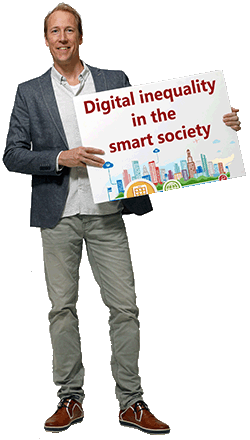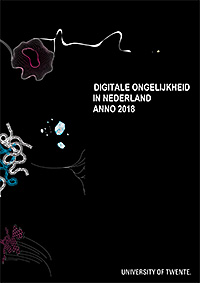21st Century digital skills
Project website: www.eskills.nl
Project website: www.eskills.nl

The main goal of the Human Capital Call is to make the Dutch creative sector an international leader by strengthening human capital among the Dutch workforce. In this regard, human capital can be considered an umbrella term covering digital literacy, creativity, critical thinking, problem solving, communicating and collaborating (OECD, 2013). Together, they create a strong base for innovative and competitive power. Our goal is to contribute to the main goal by focusing specifically on eskills of which the importance is fundamental to the wider human capital challenge. Over the last few decades, information and communication technologies (ICT) have developed as a central contributor to economic growth. However, without the required eskills, the benefits that ICT offer will not be fully realized. eSkills should be considered a requirement that is at play at all human capital components, for example by supporting critical thinking, problem solving, communication or collaboration. Thus, eskills contain both technological and higher order instances, a distinction that should be considered a critical factor in successful eskill building (Olaya Fonstad & Lanvin, 2010). eSkills should be considered the entry ticket to employment and to innovation. After all, innovation starts with people, making the level of eskills that resides within the workforce decisive. In order to create and maintain competitive advantage around eskills across its human resources, the creative sector should start with identifying and quantifying current and expected needs in eskills. Often, labor markets and educational curricula compete with one another in defining the requirements for individual workers and organizations. There is no precise operational framework available in the creative sector that can be used to provide more detailed information about actual levels of eskills among workers, or to define policy recommendations to achieve the ambitions set out by the Human Capital Agenda. As a result, it is unclear what eskills are, why workers in the creative sector would need them, how eskills will evolve, or whether eskills can be built or developed. Therefore, we do not yet know how the ambitions of the Human Capital Call can be achieved. Addressing these critical shortcomings requires a genuine consortium with partners among universities and businesses.
Problem definition and objectives
This ject has four objectives. The first objective is creating an operational eskills framework. The concept of eskills is just one of many concepts that resulted from the rapid diffusion of digital technologies into society and in the work environment. Several scholars argue that in most cases, the exact nature of such concepts is not adequately defined (Bawden, 2008; Livingstone, 2008; van Deursen, 2010). Often, people seem to believe that the definition of a term used is self-explanatory. Although most concepts lack synthesized and structured knowledge about how and why specific skills play a role, there is a widely shared sense that they are essential for successful participation in society and in the workforce. The eskill frameworks that have been developed help organizations in identifying potential problem areas, although actual measurements of these skills are very rare. Popular European frameworks are that of 21st century skills, introduced by the OECD, which refers to digital literacy, creativity, critical thinking, problem solving, collaborating and communicating (OECD, 2013). Earlier, the European eSkills Forum put forward definitions for three different types of eskills: ICT user skills, ICT practitioner skills and e-business skills (European Commission, 2004). Academic contributions suggest that the following eskills appear in some form: technical skills (that range from being comfortable with technology to reaching the level of an IT practitioner), information handling (from being able to locate and evaluate information to being able to create and synthesize information), communication (email, social networking tools, profiling and collaborating), work-related skills (depending on the industry in which the person works and the level of seniority of the person in the organization), and personal attributes (often a large variety of complex cognitive, motor, sociological, and emotional skills). In most contexts, eskills are treated as part of a broader strategy toward building the knowledge economy by promoting employment, growth, competitiveness, social inclusion, education and lifelong training. Since the concern of eskills is growing in policy discussions and improving these skills has the power to improve the competitiveness of the creative sector, there is a strong need for a definition that can guide actual measurements among the workforce in the creative sector, focusing on both technical and higher order skills. Such a definition requires both a review of existing frameworks, but also an overview of the different types of jobs in the creative sector and the skills these jobs require. The ways workers interact with ICT vary considerably, depending on the job and context of a particular employer.
This ject has four objectives. The first objective is creating an operational eskills framework. The concept of eskills is just one of many concepts that resulted from the rapid diffusion of digital technologies into society and in the work environment. Several scholars argue that in most cases, the exact nature of such concepts is not adequately defined (Bawden, 2008; Livingstone, 2008; van Deursen, 2010). Often, people seem to believe that the definition of a term used is self-explanatory. Although most concepts lack synthesized and structured knowledge about how and why specific skills play a role, there is a widely shared sense that they are essential for successful participation in society and in the workforce. The eskill frameworks that have been developed help organizations in identifying potential problem areas, although actual measurements of these skills are very rare. Popular European frameworks are that of 21st century skills, introduced by the OECD, which refers to digital literacy, creativity, critical thinking, problem solving, collaborating and communicating (OECD, 2013). Earlier, the European eSkills Forum put forward definitions for three different types of eskills: ICT user skills, ICT practitioner skills and e-business skills (European Commission, 2004). Academic contributions suggest that the following eskills appear in some form: technical skills (that range from being comfortable with technology to reaching the level of an IT practitioner), information handling (from being able to locate and evaluate information to being able to create and synthesize information), communication (email, social networking tools, profiling and collaborating), work-related skills (depending on the industry in which the person works and the level of seniority of the person in the organization), and personal attributes (often a large variety of complex cognitive, motor, sociological, and emotional skills). In most contexts, eskills are treated as part of a broader strategy toward building the knowledge economy by promoting employment, growth, competitiveness, social inclusion, education and lifelong training. Since the concern of eskills is growing in policy discussions and improving these skills has the power to improve the competitiveness of the creative sector, there is a strong need for a definition that can guide actual measurements among the workforce in the creative sector, focusing on both technical and higher order skills. Such a definition requires both a review of existing frameworks, but also an overview of the different types of jobs in the creative sector and the skills these jobs require. The ways workers interact with ICT vary considerably, depending on the job and context of a particular employer.
The second objective of the envisioned project is testing the level of eskills among workers in the creative sector. To promote employability and workforce development, and to take in a better position around global competitive challenges, the creative sector needs to gain more insight in the actual levels of eskills among its workers. Until now, the development of eskill assessments among the workforce has been hampered particularly by the lack of consensus on what constitutes measurable dimensions of eskills. Recent studies of digital skills among the general population (including higher order skills of information, communication and strategy) have shown that there is much room for improvement. While the basic skills required to use technologies are overall sufficient (with exceptions mainly in the categories of elderly and those with lower socio-economic status), higher order skills need attention urgently. However, workers in the creative sector need higher technical skills than general citizens, since there are many functions that require media-related skills. So here, the whole range of eskills, from technical to higher order is important and needs a thorough investigation. Indirect measures revealed that in work settings much time is lost due to eskill insufficiencies. The results of the eskill tests will provide information on the actual level of these skills when performed.
The third objective is determining the role of individual labor conditions and organizational functions and tasks on the level of eskills. Recent studies indicate that the importance of eskills is not acknowledged enough in organizations (Kling, 2007; van Deursen & van Dijk, 2012, 2013, 2014). One of the reasons is that people tend to rate their own skill levels higher than can be justified from scientific studies (e.g., Hargittai, 2002; Talja, 2005; van Deursen & van Dijk, 2010). People link the concept of eskills to basic technical skills, and not to higher order skills of, for example eskills required for job related collaboration. The unwelcome result is that the management of organizations does very little to improve their employees’ eskills, which causes a lot of potential productivity not being harvested. Although the importance of eskills is filtering through in policy debates, many organizations are not aware of the recent developments in the field of eskills and underestimate the need for adaptation of their human capital skills in line with both national and international economies. When the observed eskills are insufficiently developed, more effort is needed to succeed and stay competitive. However, for each individual worker, the labor situation is different and will require more or less of each of the identified eskills. In the Netherlands, van Damme et al. (2005) developed a general model to test determinants related to the labor condition. Identified determinants were the social context including home environment, indicial or collective work, autonomy of work, educational opportunities, and intensity, diversity and complexity of ICT-use. Yet, the level of eskills was not explicitly investigated. Other studies identified single factors contributing to differences in eskills. For example, the importance of so-called proxy users is pointed out; people who have someone who does things for them when it concerns the use of ICT. A variety of studies on ICT’s have highlighted the importance of informal social networks, that can exist both within and outside the official professional workplace. A lack of a supporting working environment might be corrected by more formal methods that help in developing eskills. However, it is also not clear what role educational backgrounds and accomplishments play. Participation in guided training, for example, can be an important method to develop eskills, although the effectiveness of training varies significantly depending on the instructional strategies employed . Recent research among populations at large indicates that higher order skills leave considerable room for improvement and require formal education for improvement. These higher order skills might not necessarily automatically improve through intense use of ICT’s that the working environment requires. To make things worse, concerns have been growing steadily about the ability of educational systems to provide the eskills needed by the growing share of knowledge activities. A lack of appropriate education and training seems to be an important reason why eskills are not fully being developed. There is a gap between the ability of existing educational curricula to provide skilled workers, and the requirements of the creative sector. Adjustments are needed to adapt educational systems to address eskill needs (not only in schools, but also through training at work). The identified mechanisms will help us to understand how eskills can best be learned and lead to better improved functions, productivity, creativity etc. In order to accomplish this task a general model of causes and consequences will be specified for the creative sector.
The fourth and final objective of the project is defining and testing detailed policy recommendations on how organizations can improve eskill levels of their workers. A thorough eskill framework with measureable dimensions, actual measured levels of the identified eskills, and knowing how eskills are acquired in relation to the working environment provide a solid base for direct practical recommendations that HRM- and ICT-managers can apply. Guidelines will be provided on how managers can start improving the levels of eskills among their workers. After all, the prior objectives will result in knowing which eskills need most attention and what labor conditions support required improvements. The provided recommendations will furthermore be evaluated on effectiveness. Besides advising HRM- and ICT-managers, we will be able to provide detailed recommendations to managers that are responsible for defining educational policies related to both courses in school and training at work. Furthermore, both education and the industry can be supported in matching eskill supply and demand. The developed policies will address the need to improve cooperation on a long-term basis, in order to link eskills training, education and professional development.
Published articles:
2019 - Determinants of 21st-century digital skills: A large-scale survey among working professionals






